Information Technology for Business Sustainability: A Literature Review with Automated Content Analysis
Abstract
1. Introduction
2. Methods and Data Collection
2.1. Selection of Papers
2.2. Analysis
3. Results
3.1. Field Evolvement by Numbers
3.2. Results of Content and Thematic Analysis
3.2.1. 1st Cluster: Sustainable Business
3.2.2. 2nd Cluster: Value Creation and Delivery
3.2.3. 3rd Cluster: Research
4. Discussion and Further Research Directions
4.1. Discussion of Scope and Outlets of Current Publications
4.2. Discussion of Findings
4.3. Future Research Directions
5. Conclusions and Limitations
Author Contributions
Funding
Conflicts of Interest
Appendix A
| Authors | Year | Title | Journal | Type of Paper (as Stated by Authors) | Assigned Methodological Category |
|---|---|---|---|---|---|
| Bocken, Nancy, Lisa Smeke Morales, and Matthias Lehner | 2020 | “Sufficiency Business Strategies in the Food Industry—The Case of Oatly” | Sustainability | Literature and practice review, case study | Qualitative |
| ElMassah, Suzanna, and Mahmoud Mohieldin | 2020 | “Digital Transformation and Localizing the Sustainable Development Goals (SDGs)” | Ecological Economics | Case study | Qualitative |
| Buda, Gabriella, Barbara Pethes, and Jozsef Lehota | 2020 | “Dominant Consumer Attitudes in the Sharing Economy—A Representative Study in Hungary” | Resources | Survey | Quantitative |
| Gil-Gomez, Hermenegildo, Vicente Guerola-Navarro, Raul Oltra-Badenes, and José Antonio Lozano-Quilis | 2020 | “Customer Relationship Management: Digital Transformation and Sustainable Business Model Innovation” | Economic Research-Ekonomska Istraživanja | Literature review | Theoretical |
| Bocken, Nancy | 2019 | “Sustainable Consumption through New Business Models: The Role of Sustainable Entrepreneurship” In Sustainable Entrepreneurship: Discovering, Creating and Seizing Opportunities for Blended Value Generation, edited by A. Lindgreen, F. Maon, and C. Vallaster. | Book chapter | Book chapter—exploration through illustrative cases | N/A |
| Delgado-de Miguel, Juan-Francisco, Tamar Buil-López Menchero, Miguel-Ángel Esteban-Navarro, and Miguel-Ángel García-Madurga | 2019 | “Proximity Trade and Urban Sustainability: Small Retailers’ Expectations Towards Local Online Marketplaces” | Sustainability | Semi-structured in-depth interviews | Qualitative |
| Ievoli, Corrado, Angelo Belliggiano, Danilo Marandola, Pierluigi Milone, and Pierluigi Ventura | 2019 | “Information and Communication Infrastructures and New Business Models in Rural Areas: The Case of Molise Region in Italy” | European Countryside | Case study | Qualitative |
| Ockwell, David, Joanes Atela, Kennedy Mbeva, Victoria Chengo, Rob Byrne, Rachael Durrant, Victoria Kasprowicz, and Adrian Ely | 2019 | “Can Pay-As-You-Go, Digitally Enabled Business Models Support Sustainability Transformations in Developing Countries? Outstanding Questions and a Theoretical Basis for Future Research” | Sustainability | Literature review, workshops, interviews | Qualitative |
| Olah, Judit, Nicodemus Kitukutha, Hossam Haddad, Miklos Pakurar, Domician Mate, and Jozsef Popp | 2019 | “Achieving Sustainable E-Commerce in Environmental, Social and Economic Dimensions by Taking Possible Trade-Offs” | Sustainability | Literature review and case study | Qualitative |
| Vorraber, Wolfgang, and Matthias Müller | 2019 | “A Networked Analysis and Engineering Framework for New Business Models” | Sustainability | Framework development, case study | Qualitative |
| Dumitriu, Dan, Gheorghe Militaru, Dana Corina Deselnicu, Andrei Niculescu, and Mirona Ana-Maria Popescu | 2019 | “A Perspective Over Modern SMEs: Managing Brand Equity, Growth and Sustainability Through Digital Marketing Tools and Techniques” | Sustainability | Survey | Quantitative |
| Denuwara, Navodya, Juha Maijala, and Marko Hakovirta | 2019 | “Sustainability Benefits of RFID Technology in the Apparel Industry” | Sustainability | Literature review | Theoretical |
| Freudenreich, Birte, Florian Lüdeke-Freund, and Stefan Schaltegger | 2019 | “A Stakeholder Theory Perspective on Business Models: Value Creation for Sustainability” | Journal of Business Ethics | Framework development | Theoretical |
| Gössling, Stefan, and Michael Hall | 2019 | “Sharing versus Collaborative Economy: How to Align ICT Developments and the SDGs in Tourism?” | Journal of Sustainable Tourism | Discourse analysis and literature review | Theoretical |
| Jose, Charbel, Chiappetta Jabbour, Ana Beatriz Lopes De Sousa Jabbour, Joseph Sarkis, and Godinho Filho | 2019 | “Unlocking the Circular Economy through New Business Models Based on Large-Scale Data: An Integrative Framework and Research Agenda” | Technological Forecasting and Social Change | Framework development | Theoretical |
| Parida, Vinit, and Joakim Wincent | 2019 | “Why and How to Compete through Sustainability: A Review and Outline of Trends Influencing Firm and Network-Level Transformation” | International Entrepreneurship and Management Journal | Literature review, introduction to Special Issue | Theoretical |
| Parida, Vinit, David Sjödin, and Wiebke Reim | 2019 | “Reviewing Literature on Digitalization, Business Model Innovation, and Sustainable Industry: Past Achievements and Future Promises” | Sustainability | Literature review, introduction to Special Issue, framework development | Theoretical |
| Moro Visconti, Roberto, and Donato Morea | 2019 | “Big Data for the Sustainability of Healthcare Project Financing” | Sustainability | Simulations based on empirical cases | Qualitative |
| Bouwman, Harry, Shahrokh Nikou, Francisco J Molina-Castillo, and Mark De Reuver | 2018 | “The Impact of Digitalization on Business Models” | Digital Policy, Regulation and Governance | Survey and case study | Mixed methods |
| Jabłonski, Marek | 2018 | “Value Migration to the Sustainable Business Models of Digital Economy Companies on the Capital Market” | Sustainability | Mixed methods (survey and analysis of available documents) | Mixed methods |
| Yip, Angus W. H., and Nancy Bocken | 2018 | “Sustainable Business Model Archetypes for the Banking Industry” | Journal of Cleaner Production | Literature and practice review, semi-structured interviews, survey | Mixed methods |
| Lüdeke-Freund, Florian, René Bohnsack, Henning Breuer, and Lorenzo Massa | 2018 | “Research on Sustainable Business Model Patterns: Status Quo, Methodological Issues, and a Research Agenda” In Sustainable Business Models, edited by A. Aagaard. | Book chapter | Book chapter | N/A |
| Bertola, Paola, and Jose Teunissen | 2018 | “Fashion 4.0. Innovating Fashion Industry through Digital Transformation” | Research Journal of Textile and Apparel | Positioning essay enriched by case studies | Qualitative |
| Bressanelli, Gianmarco, Federico Adrodegari, Marco Perona, and Nicola Saccani | 2018 | “Exploring How Usage-Focused Business Models Enable Circular Economy through Digital Technologies” | Sustainability | Framework development based on literature and case study | Qualitative |
| Hildebrandt, Björn, Andre Hanelt, and Sebastian Firk | 2018 | “Sharing Yet Caring: Mitigating Moral Hazard in Access-Based Consumption through IS-Enabled Value Co-Capturing with Consumers” | Business and Information Systems Engineering | Quasi-experimental research design based on a case study | Qualitative |
| Piscicelli, Laura, Geke D S Ludden, and Tim Cooper | 2018 | “What Makes a Sustainable Business Model Successful? An Empirical Comparison of Two Peer-to-Peer Goods-Sharing Platforms” | Journal of Cleaner Production | Case study | Qualitative |
| Pohludka, Michal, Hana Stverkova, and Beata Ślusarczyk | 2018 | “Implementation and Unification of the ERP System in a Global Company as a Strategic Decision for Sustainable Entrepreneurship” | Sustainability | Case study | Qualitative |
| Rajala, Risto, Esko Hakanen, Juri Matilla, Timo Seppälä, and Mika Westerlund | 2018 | “How Do Intelligent Goods Shape Closed-Loop Systems?” | California Management Review | Case study | Qualitative |
| Bieser, Jan C. T., and Lorenz M. Hilty | 2018 | “Assessing Indirect Environmental Effects of Information and Communication Technology (ICT): A Systematic Literature Review” | Sustainability | Literature review | Theoretical |
| Brenner, Barbara | 2018 | “Transformative Sustainable Business Models in the Light of the Digital Imperative—A Global Business Economics Perspective’ | Sustainability | Framework development based on literature and practice review | Theoretical |
| Camacho-Otero, Juana, Casper Boks, and Ida Nilstad Pettersen | 2018 | ‘Consumption in the Circular Economy: A Literature Review” | Sustainability | Literature review | Theoretical |
| Dentchev, Nikolay, Romana Rauter, Lára Jóhannsdóttir, Yuliya Snihur, Michele Rosano, Rupert Baumgartner, Timo Nyberg, Xingfu Tang, Bart van Hoof, and Jan Jonker | 2018 | “Embracing the Variety of Sustainable Business Models: A Prolific Field of Research and a Future Research Agenda” | Journal of Cleaner Production | Overview—an introduction to the Special Issue | Theoretical |
| Jin, Yuran, and Shoufeng Ji | 2018 | “Mapping Hotspots and Emerging Trends of Business Model Innovation under Networking in Internet of Things” | Journal on Wireless Communications and Networking | Scientometric analysis | Theoretical |
| Shetty, Vivek, John Yamamoto, and Kenneth Yale | 2018 | “Re-Architecting Oral Healthcare for the 21st Century” | Journal of Dentistry | Overview (methodology not stated in the paper) | Theoretical |
| Geissdoerfer, Martin, Doroteya Vladimirova, and Steve Evans | 2018 | “Sustainable Business Model Innovation: A Review” | Journal of Cleaner Production | Literature review | Theoretical |
| Mountean, Mihaela | 2018 | “Business Intelligence Issues for Sustainability Projects”. | Sustainability | Multi-dimensional data modeling | Theoretical |
| Baldassarre, B., G. Calabretta, Nancy Bocken, and T. Jaskiewicz | 2017 | “Bridging Sustainable Business Model Innovation and User-Driven Innovation: A Process for Sustainable Value Proposition Design” | Journal of Cleaner Production | Research through design | Qualitative |
| Hanelt, Andre, Sebastian Busse, and Lutz M. Kolbe | 2017 | “Driving Business Transformation toward Sustainability: Exploring the Impact of Supporting IS on the Performance Contribution of Eco-Innovations” | Information Systems Journal | Case study | Qualitative |
| Moreno, Mariale, Christopher Turner, Ashutosh Tiwari, Windo Hutabarat, Fiona Charnley, Debora Widjaja, and Luigi Mondini | 2017 | “Re-Distributed Manufacturing to Achieve a Circular Economy: A Case Study Utilizing IDEF0 Modeling” | Conference proceedings | Case study | Qualitative |
| Yang, M, S Evans, D Vladimirova, and P Rana | 2017 | “Value Uncaptured Perspective for Sustainable Business Model Innovation” | Journal of Cleaner Production | Framework development, case study | Qualitative |
| Evans, Steve, Doroteya Vladimirova, Maria Holgado, Kirsten Van Fossen, Miying Yang, Elisabete A. Silva, and Claire Y. Barlow | 2017 | “Business Model Innovation for Sustainability: Towards a Unified Perspective for Creation of Sustainable Business Models” | Business Strategy and the Environment | Literature review | Theoretical |
| Lüdeke-Freund, Florian, and Krzysztof Dembek | 2017 | “Sustainable Business Model Research and Practice: Emerging Field or Passing Fancy?” | Journal of Cleaner Production | Analysis of emerging research field | Theoretical |
| Pagoropoulos, Aris, Daniela C. A. Pigosso, and Tim C. McAloone | 2017 | “The Emergent Role of Digital Technologies in the Circular Economy: A Review” | Conference proceedings | Literature review | Theoretical |
| Seele, Peter, and Irina Lock | 2017 | “The Game-Changing Potential of Digitalization for Sustainability: Possibilities, Perils, and Pathways” | Sustain Sci | Editorial, introduction to Special Issue | Theoretical |
| Bocken, Nancy, and S. W. Short | 2016 | “Towards a Sufficiency-Driven Business Model: Experiences and Opportunities” | Environmental Innovation and Societal Transitions | Case study | Qualitative |
| Breidbach, Christoph F., and Paul P. Maglio | 2016 | “Technology-Enabled Value Co-Creation: An Empirical Analysis of Actors, Resources, and Practices” | Industrial Marketing Management | Case study | Qualitative |
| Heiskala, Mikko, Jani-Pekka Jokinen, and Markku Tinnilä | 2016 | “Crowdsensing-Based Transportation Services—An Analysis from Business Model and Sustainability Viewpoints” | Research in Transportation Business and Management | Case study | Qualitative |
| Davidsson, Paul, Banafsheh Hajinasab, Johan Holmgren, Åse Jevinger, and Jan Persson | 2016 | “The Fourth Wave of Digitalization and Public Transport: Opportunities and Challenges” | Sustainability | Analysis of literature and explorative studies | Theoretical |
| Schaltegger, Stefan, Erik G Hansen, and Florian Lüdeke-Freund | 2016 | “Business Models for Sustainability: Origins, Present Research, and Future Avenues” | Organization and Environment | Editorial, introduction to Special Issue | Theoretical |
| Upward, Anthony, and Peter H. Jones. 2015 | 2015 | “An Ontology for Strongly Sustainable Business Models: Defining an Enterprise Framework Compatible with Natural and Social Science” | Organization and Environment | Framework development | Theoretical |
| Bocken, Nancy, S. W. Short, P. Rana, and S. Evans | 2014 | “A Literature and Practice Review to Develop Sustainable Business Model Archetypes” | Journal of Cleaner Production | Literature and practice review | Theoretical |
| Bohnsack, René, Jonatan Pinkse, and Ans Kolk | 2014 | “Business Models for Sustainable Technologies: Exploring Business Model Evolution in the Case of Electric Vehicles” | Research Policy | Content analysis | Theoretical |
| Boons, Frank, and Florian Lüdeke-Freund | 2013 | “Business Models for Sustainable Innovation: State-of-the-Art and Steps towards a Research Agenda” | Journal of Cleaner Production | Literature review | Theoretical |
| Boons, Frank, Carlos Montalvo, Jaco Quist, and Marcus Wagner | 2013 | “Sustainable Innovation, Business Models and Economic Performance: An Overview” | Journal of Cleaner Production | Overview—an introduction to the Special Issue | Theoretical |
| Schaltegger, Stefan, Florian Lüdeke-Freund, and Erik G Hansen | 2012 | “Business Cases for Sustainability The Role of Business Model Innovation for Corporate Sustainability” | International Journal of Innovation and Sustainable Development | Framework development | Theoretical |
| Dao, Viet, Ian Langella, and Jerry Carbo | 2011 | “From Green to Sustainability: Information Technology and an Integrated Sustainability Framework” | Journal of Strategic Information Systems | Framework development | Theoretical |
| Elliot, Steve | 2011 | “Transdisciplinary Perspectives on Environmental Sustainability: A Resource Base and Framework for IT-Enabled Business Transformation” | MIS Quarterly | Literature review and framework development | Theoretical |
| Doz, Yves L, and Mikko Kosonen | 2010 | “Embedding Strategic Agility A Leadership Agenda for Accelerating Business Model Renewal” | Long Range Planning | Proposition of actions for renewal and transformation of business models based on practice review | Qualitative |
| Lüdeke-Freund, Florian | 2010 | “Towards a Conceptual Framework of ’Business Models for Sustainability” | Conference proceedings | Framework development | Theoretical |
| Melville, Nigel P. | 2010 | “Information Systems Innovation for Environmental Sustainability” | MIS Quarterly | Development of research agenda and framework | Theoretical |
| Stubbs, Wendy, and Chris Cocklin | 2008 | “Conceptualizing a ‘Sustainability Business Model’” | Organization and Environment | Case study, framework development | Qualitative |
References
- Nosratabadi, S.; Mosavi, A.; Shamshirband, S.; Kazimieras Zavadskas, E.; Rakotonirainy, A.; Chau, K.W. Sustainable Business Models: A Review. Sustainability 2019, 11, 1663. [Google Scholar] [CrossRef]
- Boons, F.; Lüdeke-Freund, F. Business models for sustainable innovation: State-of-the-art and steps towards a research agenda. J. Clean. Prod. 2013, 45, 9–19. [Google Scholar] [CrossRef]
- Stubbs, W.; Cocklin, C. Conceptualizing a “Sustainability Business Model”. Organ. Environ. 2008, 21, 103–127. [Google Scholar] [CrossRef]
- Dentchev, N.; Rauter, R.; Jóhannsdóttir, L.; Snihur, Y.; Rosano, M.; Baumgartner, R.; Nyberg, T.; Tang, X.; van Hoof, B.; Jonker, J. Embracing the variety of sustainable business models: A prolific field of research and a future research agenda. J. Clean. Prod. 2018, 194, 695–703. [Google Scholar] [CrossRef]
- Lüdeke-Freund, F.; Dembek, K. Sustainable business model research and practice: Emerging field or passing fancy? J. Clean. Prod. 2017, 168, 1668–1678. [Google Scholar] [CrossRef]
- Bocken, N.M.P.; Short, S.W.; Rana, P.; Evans, S. A literature and practice review to develop sustainable business model archetypes. J. Clean. Prod. 2014, 65, 42–56. [Google Scholar] [CrossRef]
- Broman, G.I.; Robert, K.-H. A framework for strategic sustainable development. J. Clean. Prod. 2015, 140, 1–15. [Google Scholar] [CrossRef]
- Evans, S.; Vladimirova, D.; Holgado, M.; Van Fossen, K.; Yang, M.; Silva, E.A.; Barlow, C.Y. Business Model Innovation for Sustainability: Towards a Unified Perspective for Creation of Sustainable Business Models. Bus. Strategy Environ. 2017, 26, 597–608. [Google Scholar] [CrossRef]
- Schaltegger, S.; Hansen, E.G.; Lüdeke-Freund, F. Business Models for Sustainability: Origins, Present Research, and Future Avenues. Organ. Environ. 2016, 29, 3–10. [Google Scholar] [CrossRef]
- Upward, A.; Jones, P.H. An Ontology for Strongly Sustainable Business Models: Defining an Enterprise Framework Compatible with Natural and Social Science. Organ. Environ. 2015, 29, 97–123. [Google Scholar] [CrossRef]
- Vial, G. Understanding digital transformation: A review and a research agenda. J. Strategy Inf. Syst. 2019, 28, 118–144. [Google Scholar] [CrossRef]
- Chesbrough, H. Business model innovation: It’s not just about technology anymore. Strategy Leadersh. 2007, 35, 12–17. [Google Scholar] [CrossRef]
- Chesbrough, H. Business model innovation: Opportunities and barriers. Long Range Plann. 2010, 43, 354–363. [Google Scholar] [CrossRef]
- Lüdeke-Freund, F. Towards a Conceptual Framework of Business Models for Sustainability. In Proceedings of the Knowledge Collaboration & Learning for Sustainable Innovation—Conference Proceedings, 14th European Roundtable on Sustainable Consumption and Production (ERSCP) & 6th Environmental Management for Sustainable Universities (EMSU), Delft, The Netherlands, 25–29 October 2010. [Google Scholar]
- Schaltegger, S.; Lüdeke-Freund, F.; Hansen, E.G. Business Cases for Sustainability The Role of Business Model Innovation for Corporate Sustainability. Int. J. Innov. Sustain. Dev. 2012, 6, 95. [Google Scholar] [CrossRef]
- Bouwman, H.; Nikou, S.; Molina-Castillo, F.J.; De Reuver, M. The Impact of Digitalization on Business Models. Digit. Policy Regul. Gov. 2018, 20, 105–124. [Google Scholar] [CrossRef]
- Parida, V.; Sjödin, D.; Reim, W. Reviewing Literature on Digitalization, Business Model Innovation, and Sustainable Industry: Past Achievements and Future Promises. Sustainability 2019, 11, 391. [Google Scholar] [CrossRef]
- Rayna, T.; Striukova, L. From rapid prototyping to home fabrication: How 3D printing is changing business model innovation. Technol. Forecast. Soc. Chang. 2016, 102, 214–224. [Google Scholar] [CrossRef]
- Tiscini, R.; Testarmata, S.; Ciaburri, M.; Ferrari, E. The blockchain as a sustainable business model innovation. Manag. Decis. 2020, 58. [Google Scholar] [CrossRef]
- Amit, R.; Zott, C. Business Model Innovation Strategy: Transformational Concepts and Tools for Entrepreneurial Leaders; John Wiley & Son Ltd.: Hoboken, NJ, USA, 2020. [Google Scholar]
- Melville, N.; Kraemer, K.; Gurbaxani, V.; Carroll, W.E. Review: Information Technology and Organizational Performance: An Integrative Model of IT Business Value. MIS Q. 2004, 28, 283–322. [Google Scholar] [CrossRef]
- Dao, V.; Langella, I.; Carbo, J. From green to sustainability: Information Technology and an integrated sustainability framework. J. Strategy Inf. Syst. 2011, 20, 63–79. [Google Scholar] [CrossRef]
- Melville, N.P. Information Systems Innovation for Environmental Sustainability. MIS Q. 2010, 34, 1–21. [Google Scholar] [CrossRef]
- Watson, R.T.; Boudreau, M.-C.; Chen, A.J. Information Systems and Environmentally Sustainable Development: Energy Informatics and New Directions for the IS Community. Source MIS Q. 2010, 34, 23–38. [Google Scholar] [CrossRef]
- Boudreau, M.-C.; Chen, A.; Huber, M. Green IS: Building Sustainable Business Practices; Watson, R.T., Ed.; Information Systems, Global Text Project: Athens, GA, USA, 2008. [Google Scholar]
- Gholami, R.; Sulaiman, A.B.; Ramayah, T.; Molla, A. Senior managers’ perception on green information systems (IS) adoption and environmental performance: Results from a field survey. Inf. Manag. 2013, 50, 431–438. [Google Scholar] [CrossRef]
- Molla, A.; Cooper, V.; Pittayachawan, S. IT and eco-sustainability: Developing and validating a green IT readiness model. In Proceedings of the Thirtieth International Conference on Information Systems, Phoenix, AZ, USA, 15–18 December 2009. [Google Scholar]
- Faucheux, S.; Nicolaï, I. IT for green and green IT: A proposed typology of eco-innovation. Ecol. Econ. 2011, 70, 2020–2027. [Google Scholar] [CrossRef]
- Hedman, J.; Henningsson, S.; Selander, L. Organizational Self-Renewal: The Role of Green Is in Developing Eco-effectiveness. In Proceedings of the ICIS 2012 Proceedings, Orlando, FL, USA, 16–19 December 2012. [Google Scholar]
- Molla, A.; Abareshi, A.; Cooper, V. Green IT beliefs and pro-environmental IT practices among IT professionals. Inf. Technol. People 2012, 27, 129–154. [Google Scholar] [CrossRef]
- Kane, G.C.; Palmer, D.; Phillips, A.N.; Kiron, D.; Buckley, N. Achieving Digital Maturity; MIT Sloan Management Review; Deloitte University Press: Boston, MA, USA, 2017. [Google Scholar]
- Kane, G.C.; Palmer, D.; Phillips, A.N.; Kiron, D.; Buckley, N. Coming of Age Digitally: Learning, Leadership, and Legacy; MIT Sloan Management Review; Deloitte Insights: Boston, MA, USA, 2018. [Google Scholar]
- Sebastian, I.M.; Mocker, M.; Ross, J.W.; Moloney, K.G.; Beath, C.; Fonstad, N.O. How Big Old Companies Navigate Digital Transformation. MIS Q. Exec. 2017, 16, 197–213. [Google Scholar]
- Hanelt, A.; Busse, S.; Kolbe, L.M. Driving business transformation toward sustainability: Exploring the impact of supporting IS on the performance contribution of eco-innovations. Inf. Syst. J. 2017, 27, 463–502. [Google Scholar] [CrossRef]
- Hildebrandt, B.; Hanelt, A.; Firk, S. Sharing Yet Caring: Mitigating Moral Hazard in Access-Based Consumption through IS-Enabled Value Co-Capturing with Consumers. Bus. Inf. Syst. Eng. 2018, 60, 227–241. [Google Scholar] [CrossRef]
- Kathan, W.; Matzler, K.; Veider, V. The sharing economy: Your business model’s friend or foe? Bus. Horiz. 2016, 59, 663–672. [Google Scholar] [CrossRef]
- Gil-Gomez, H.; Guerola-Navarro, V.; Oltra-Badenes, R.; Lozano-Quilis, J.A. Customer relationship management: Digital transformation and sustainable business model innovation. Econ. Res. Istraž. 2020, 33, 2733–2750. [Google Scholar] [CrossRef]
- Ockwell, D.; Atela, J.; Mbeva, K.; Chengo, V.; Byrne, R.; Durrant, R.; Kasprowicz, V.; Ely, A. Can Pay-As-You-Go, Digitally Enabled Business Models Support Sustainability Transformations in Developing Countries? Outstanding Questions and a Theoretical Basis for Future Research. Sustainability 2019, 11, 2105. [Google Scholar] [CrossRef]
- Dumitriu, D.; Militaru, G.; Deselnicu, D.C.; Niculescu, A.; Popescu, M.A.-M. A Perspective Over Modern SMEs: Managing Brand Equity, Growth and Sustainability Through Digital Marketing Tools and Techniques. Sustainability 2019, 11, 2111. [Google Scholar] [CrossRef]
- Jose, C.; Jabbour, C.; De Sousa Jabbour, A.B.L.; Sarkis, J.; Filho, G. Unlocking the circular economy through new business models based on large-scale data: An integrative framework and research agenda. Technol. Forecast. Soc. Chang. 2019, 144, 546–552. [Google Scholar] [CrossRef]
- Brenner, B. Transformative Sustainable Business Models in the Light of the Digital Imperative—A Global Business Economics Perspective. Sustainability 2018, 10, 4428. [Google Scholar] [CrossRef]
- European Commission Communication from the Commission to the European Parliament, the Council, the European Central Bank, the European Economic and Social Committee, the Committee of the Regions and the European Investment Bank Annual Growth Survey. 2018. Available online: https://www.eumonitor.eu/9353000/1/j9vvik7m1c3gyxp/vkjl90nh6wxh (accessed on 31 July 2018).
- Seele, P.; Lock, I. The game-changing potential of digitalization for sustainability: Possibilities, perils, and pathways. Sustain. Sci. 2017, 12, 183–185. [Google Scholar] [CrossRef]
- Moher, D.; Liberati, A.; Tetzlaff, J.; Altman, D.G. The PRISMA Group Preferred Reporting Items for Systematic Reviews and Meta-Analyses: The PRISMA Statement. PLoS Med. 2009, 6. [Google Scholar] [CrossRef]
- Levy, Y.; Ellis, T. A Systems Approach to Conduct an Effective Literature Review in Support of Information Systems Research. Inf. Sci. 2006, 9, 181–212. [Google Scholar] [CrossRef]
- Kitchenham, B.; Charters, S. Guidelines for Performing Systematic Literature Reviews in Software Engineering; Software Engineering Group, School of Computer Science and Mathematics, Keele University: Staffs, UK; Department of Computer Science, University of Durham: Durham, UK, 2007. [Google Scholar]
- Elo, S.; Kyngäs, H. The qualitative content analysis process. J. Adv. Nurs. 2008, 62, 107–115. [Google Scholar] [CrossRef]
- Mayring, P. Qualitative Content Analysis. Theoretical Foundation, Basic Procedures and Software Solution; Social Science Open Access Repository: Klagenfurt, Austria, 2014. [Google Scholar]
- Hsieh, H.F.; Shannon, S.E. Three approaches to qualitative content analysis. Qual. Health Res. 2005, 15, 1277–1288. [Google Scholar] [CrossRef]
- Flick, U. An Introduction to Qualitative Research, 4th ed.; Sage Publications Ltd.: New York, NY, USA, 2009. [Google Scholar]
- Tableau. Available online: https://www.tableau.com/ (accessed on 16 April 2020).
- Leximancer. Available online: https://info.leximancer.com/ (accessed on 16 April 2020).
- Randhawa, K.; Wilden, R.; Hohberger, J. A Bibliometric Review of Open Innovation: Setting a Research Agenda. J. Prod. Innov. Manag. 2016, 33, 750–772. [Google Scholar] [CrossRef]
- Pucihar, A. The digital transformation journey: Content analysis of Electronic Markets articles and Bled eConference proceedings from 2012 to 2019. Electron. Mark. 2020, 30, 29–37. [Google Scholar] [CrossRef]
- Geissdoerfer, M.; Vladimirova, D.; Evans, S. Sustainable business model innovation: A review. J. Clean. Prod. 2018, 198, 401–416. [Google Scholar] [CrossRef]
- Bocken, N.; Smeke Morales, L.; Lehner, M. Sufficiency Business Strategies in the Food Industry—The Case of Oatly. Sustainability 2020, 12, 824. [Google Scholar] [CrossRef]
- Piscicelli, L.; Ludden, G.D.S.; Cooper, T. What makes a sustainable business model successful? An empirical comparison of two peer-to-peer goods-sharing platforms. J. Clean. Prod. 2018, 172, 4580–4591. [Google Scholar] [CrossRef]
- Zott, C.; Amit, R.; Massa, L. The Business Model: Recent Developments and Future Research. J. Manag. 2011, 37, 1019–1042. [Google Scholar] [CrossRef]
- Yang, M.; Evans, S.; Vladimirova, D.; Rana, P. Value uncaptured perspective for sustainable business model innovation. J. Clean. Prod. 2017, 140, 1794–1804. [Google Scholar] [CrossRef]
- Teece, D.J. Business models, business strategy and innovation. Long Range Plan. 2010, 43, 172–194. [Google Scholar] [CrossRef]
- Freudenreich, B.; Lüdeke-Freund, F.; Schaltegger, S. A Stakeholder Theory Perspective on Business Models: Value Creation for Sustainability. J. Bus. Ethics 2019, 166, 1–16. [Google Scholar] [CrossRef]
- Richardson, J. The Business Model: An Integrative Framework for Strategy Execution. Strateg. Chang. 2008, 17, 133–144. [Google Scholar] [CrossRef]
- Osterwalder, A.; Pigneur, Y. Business Model Generation; John Wiley and Sons: New York, NY, USA, 2010. [Google Scholar]
- Baldassarre, B.; Calabretta, G.; Bocken, N.; Jaskiewicz, T. Bridging sustainable business model innovation and user-driven innovation: A process for sustainable value proposition design. J. Clean. Prod. 2017, 147, 175–186. [Google Scholar] [CrossRef]
- Vladimirova, D. Building Sustainable Value Propositions for Multiple Stakeholders: A Practical Tool. J. Bus. Model. 2019, 7, 1–8. [Google Scholar]
- Jabłonski, M. Value Migration to the Sustainable Business Models of Digital Economy Companies on the Capital Market. Sustainability 2018, 10, 3113. [Google Scholar] [CrossRef]
- Chian Tan, F.T.; Cahalane, M.; Tan, B.; Englert, J. How GoGet CarShare’s Product-Service System is Facilitating Collaborative Consumption. MIS Q. Exec. 2017, 16, 265–277. [Google Scholar]
- Heiskala, M.; Jokinen, J.-P.; Tinnilä, M. Crowdsensing-based transportation services—An analysis from business model and sustainability viewpoints. Res. Transp. Bus. Manag. 2016, 18, 38–48. [Google Scholar] [CrossRef]
- Gössling, S.; Hall, M. Sharing versus collaborative economy: How to align ICT developments and the SDGs in tourism? J. Sustain. Tour. 2019, 27, 74–96. [Google Scholar] [CrossRef]
- Breidbach, C.F.; Maglio, P.P. Technology-enabled value co-creation: An empirical analysis of actors, resources, and practices. Ind. Mark. Manag. 2016, 56, 73–85. [Google Scholar] [CrossRef]
- Malhotra, A.; Melville, N.P.; Ross, S.M.; Watson, R.T. Spurring Impactful Research on Information Systems for Environmental Sustainability. MIS Q. 2013, 37, 1265–1274. [Google Scholar] [CrossRef]
- Cooper, V.; Molla, A. Information systems absorptive capacity for environmentally driven IS-enabled transformation. Inf. Syst. J. 2017, 27, 379–425. [Google Scholar] [CrossRef]
- Ripple, W.J.; Wolf, C.; Newsome, T.M.; Galetti, M.; Alamgir, M.; Crist, E.; Mahmoud, M.I.; Laurance, W.F. World Scientists’ Warning to Humanity: A Second Notice. Bioscience 2017, 67, 1026–1028. [Google Scholar] [CrossRef]
- Lessambo, F.I. Corporate Governance in Continental Europe. In The International Corporate Governance System; Palgrave Macmillan: London, UK, 2014; pp. 114–129. [Google Scholar]
- Lessambo, F.I. Corporate Governance in the United States of America. In The International Corporate Governance System; Palgrave Macmillan: London, UK, 2014; pp. 46–80. [Google Scholar]
- Alt, R. Electronic Markets on sustainability. Electron. Mark. 2020, 30, 667–674. [Google Scholar] [CrossRef]
- Gholami, R.; Watson, R.T.; Hasan, H.; Molla, A.; Bjorn-Andersen, N. Information Systems Solutions for Environmental Sustainability: How Can We Do More? J. Assoc. Inf. Syst. 2016, 17. [Google Scholar] [CrossRef]
- Elliot, S.; Webster, J. Editorial: Special issue on empirical research on information systems addressing the challenges of environmental sustainability: An imperative for urgent action. Inf. Syst. J. 2017, 27, 367–378. [Google Scholar] [CrossRef]
- Jeansson, J.; Bredmar, K. Digital Transformation of SMEs: Capturing Complexity. In Humanizing Technology for a Sustainable Society, Proceedings of the 32nd Bled eConference, Bled, Slovenia, 16–19 June 2019; Pucihar, A., Kljajić Borštnar, M., Bons, R., Seitz, J., Cripps, H., Vidmar, D., Eds.; University of Maribor Press: Maribor, Slovenia, 2019; pp. 523–541. [Google Scholar]
- European Commission. Member State Implementation of Directive 2014/95/EU; European Commission: Brussels, Belgium, 2017. [Google Scholar]
- European Parliament and the Council of the European Union. DIRECTIVE 2014/95/EU; European Parliament and the Council of the European Union: Strasbourg, France, 2014. [Google Scholar]
- Bressanelli, G.; Adrodegari, F.; Perona, M.; Saccani, N. Exploring How Usage-Focused Business Models Enable Circular Economy through Digital Technologies. Sustainability 2018, 10, 639. [Google Scholar] [CrossRef]
- Camacho-Otero, J.; Boks, C.; Nilstad Pettersen, I. Consumption in the Circular Economy: A Literature Review. Sustainability 2018, 10, 2758. [Google Scholar] [CrossRef]
- Seidel, S.; Bharati, P.; Fridgen, G.; Watson, R.T.; Albizri, A.; Boudreau, M.-C.; Butler, T.; Kruse, L.C.; Guzman, I.; Karsten, H.; et al. The Sustainability Imperative in Information Systems Research. Commun. Assoc. Inf. Syst. 2017, 40, 3. [Google Scholar] [CrossRef]
- Parida, V.; Wincent, J. Why and how to compete through sustainability: A review and outline of trends influencing firm and network-level transformation. Int. Entrep. Manag. J. 2019, 15, 1–19. [Google Scholar] [CrossRef]
- Hedman, J.; Henningsson, S. Developing ecological sustainability: A green IS response model. Inf. Syst. J. 2016, 26, 259–287. [Google Scholar] [CrossRef]
- Kurkalova, L.A.; Carter, L. Sustainable production: Using simulation modeling to identify the benefits of green information systems. Decis. Support Syst. 2017, 96, 83–91. [Google Scholar] [CrossRef]
- European Commission. Monitoring the Digital Economy & Society 2016–2021; European Commission: Brussels, Belgium, 2015; Volume 52. [Google Scholar] [CrossRef]
- European Commission. Integration of Digital Technology: Europe’s Digital Progress Report 2017; European Commission: Brussels, Belgium, 2017. [Google Scholar]
- Levstek, A.; Hovelja, T.; Pucihar, A. IT Governance Mechanisms and Contingency Factors: Towards an Adaptive IT Governance Model. Organizacija 2018, 51, 286–310. [Google Scholar] [CrossRef]
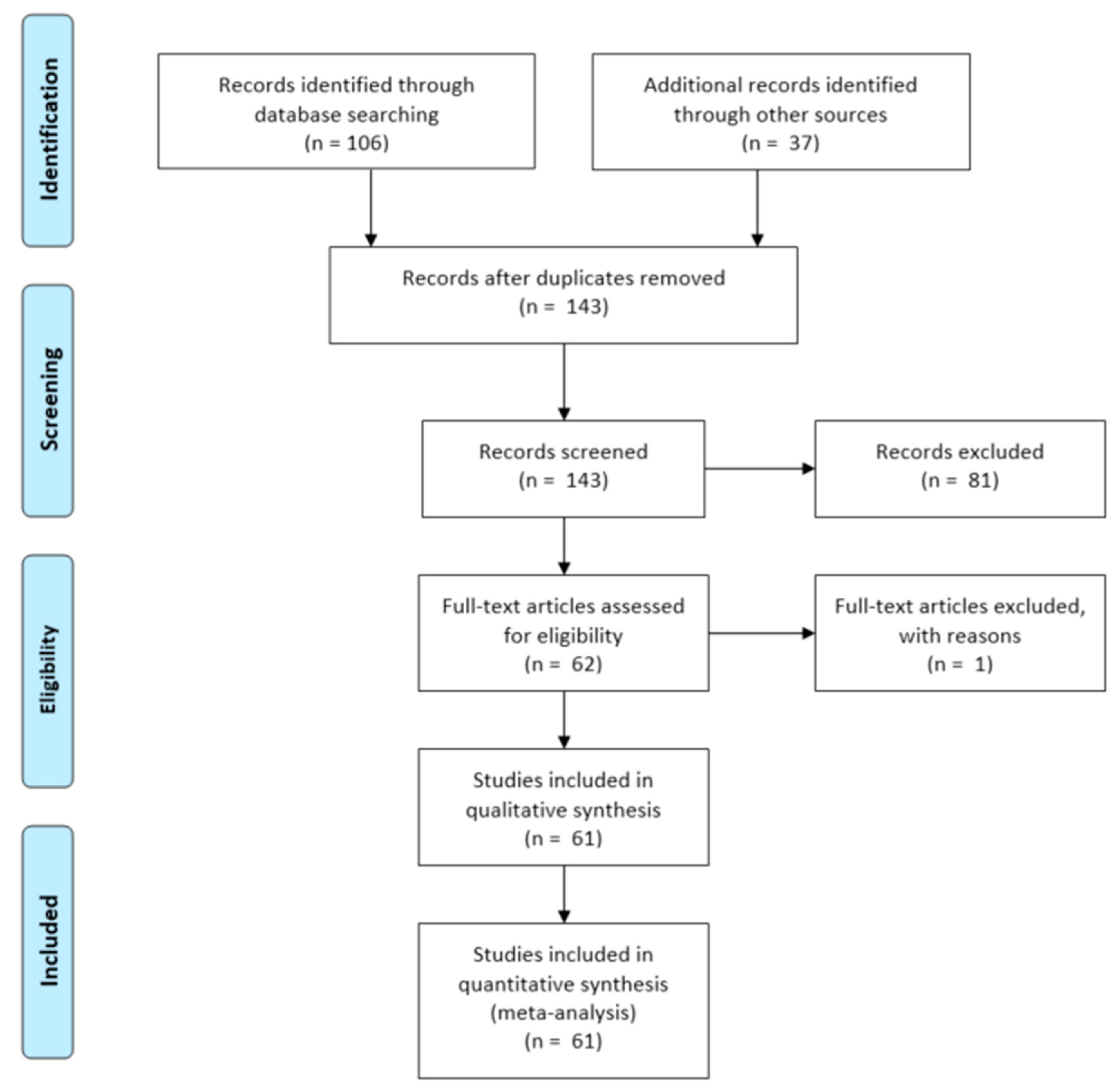
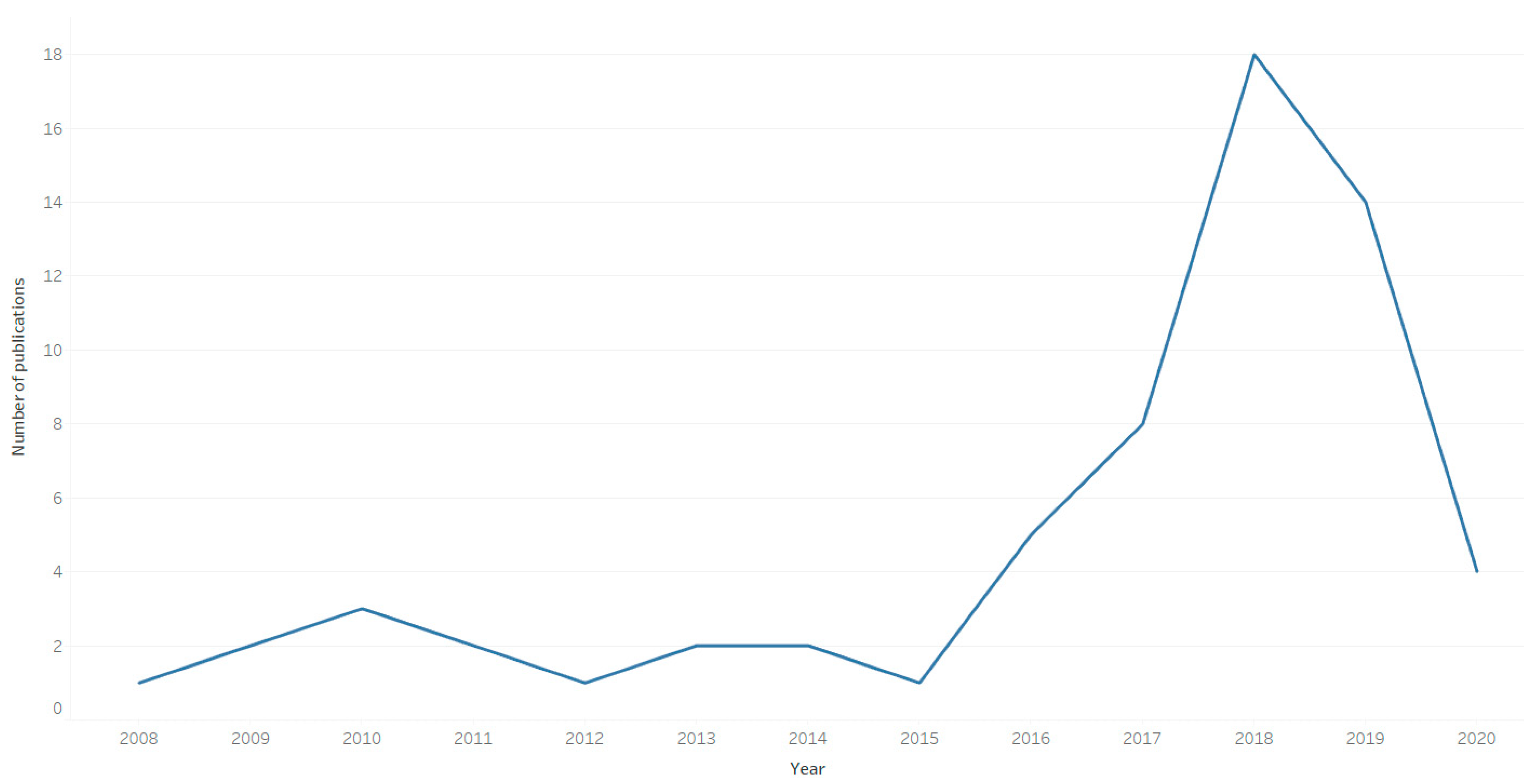
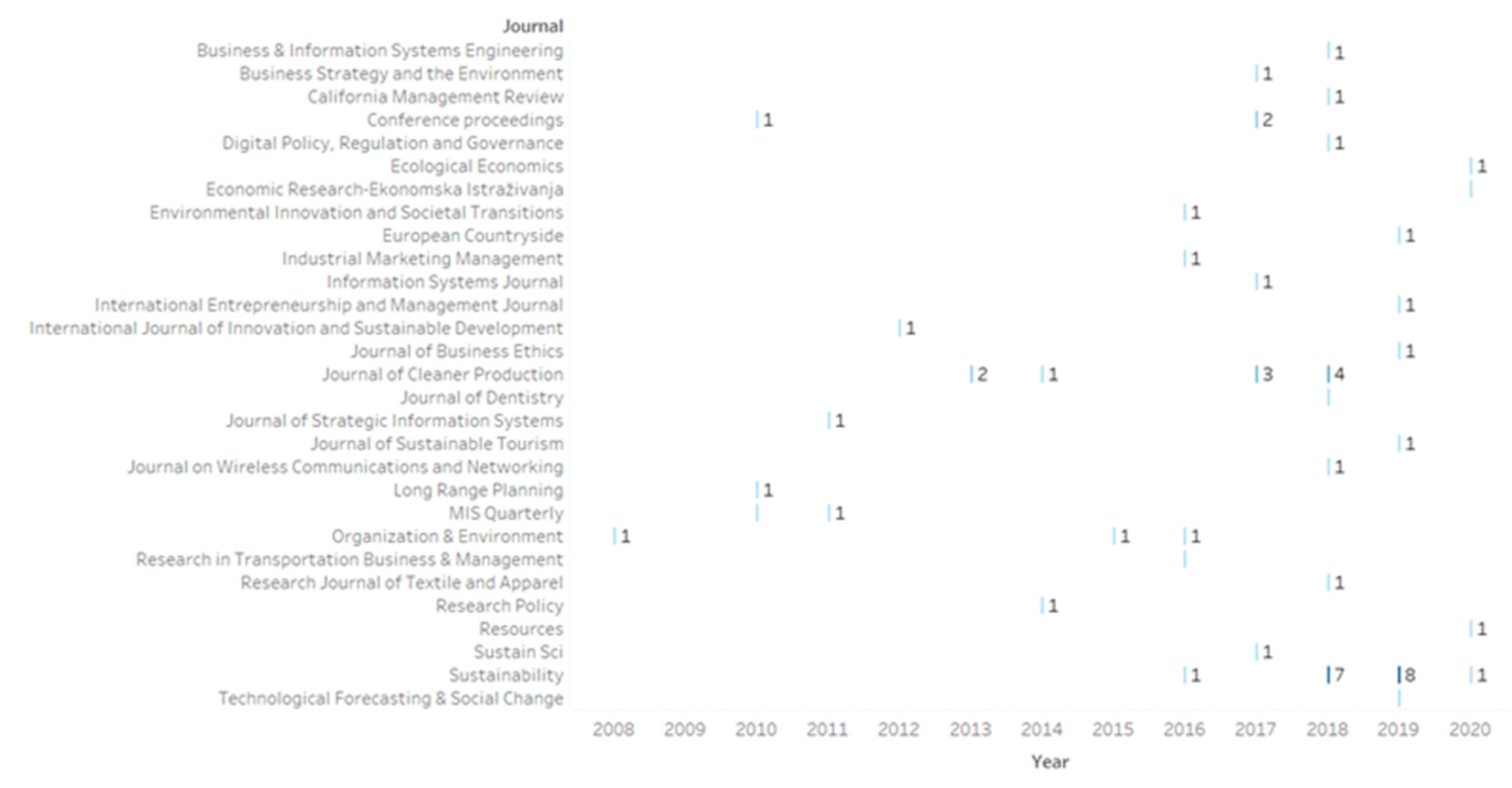

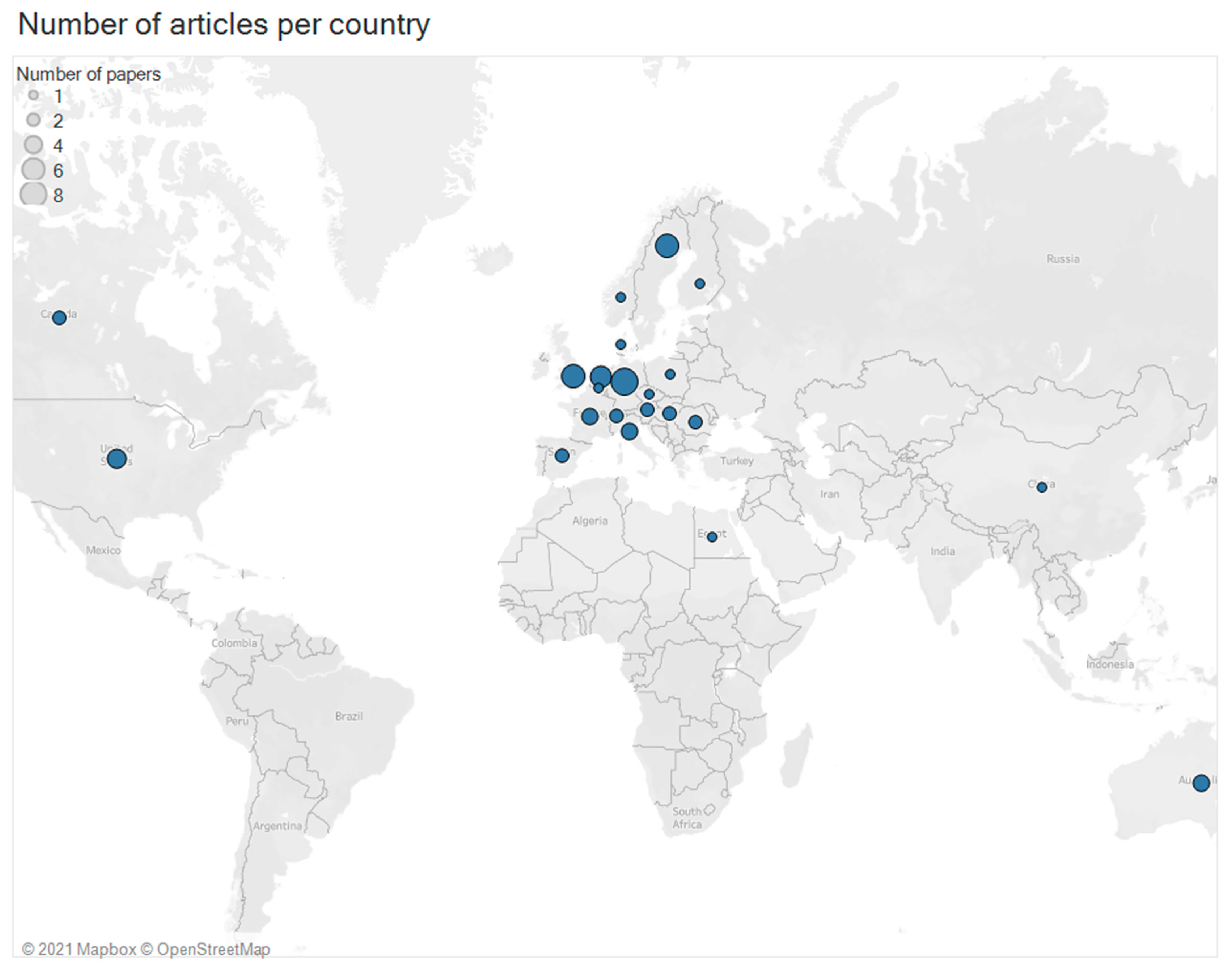
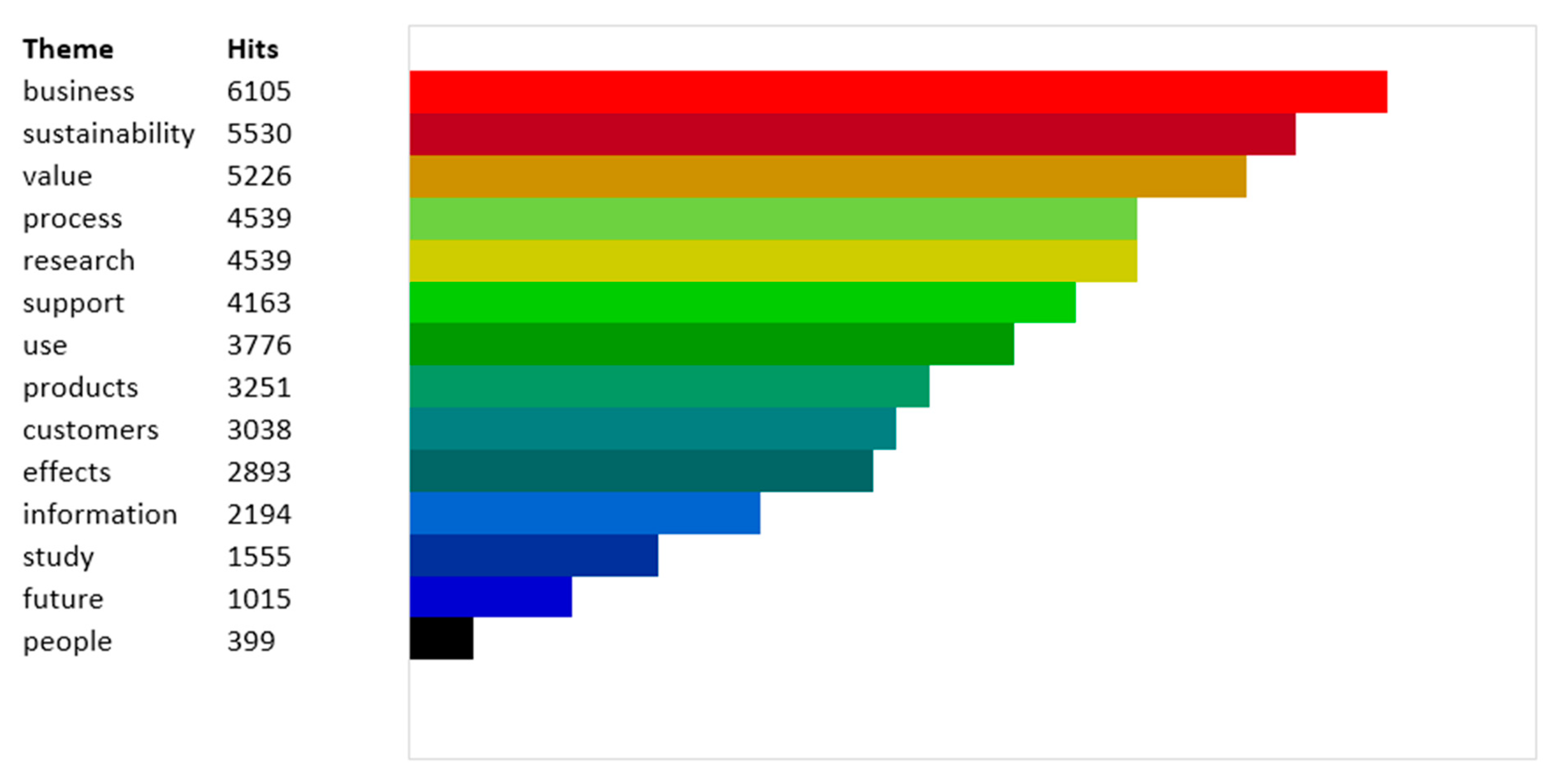
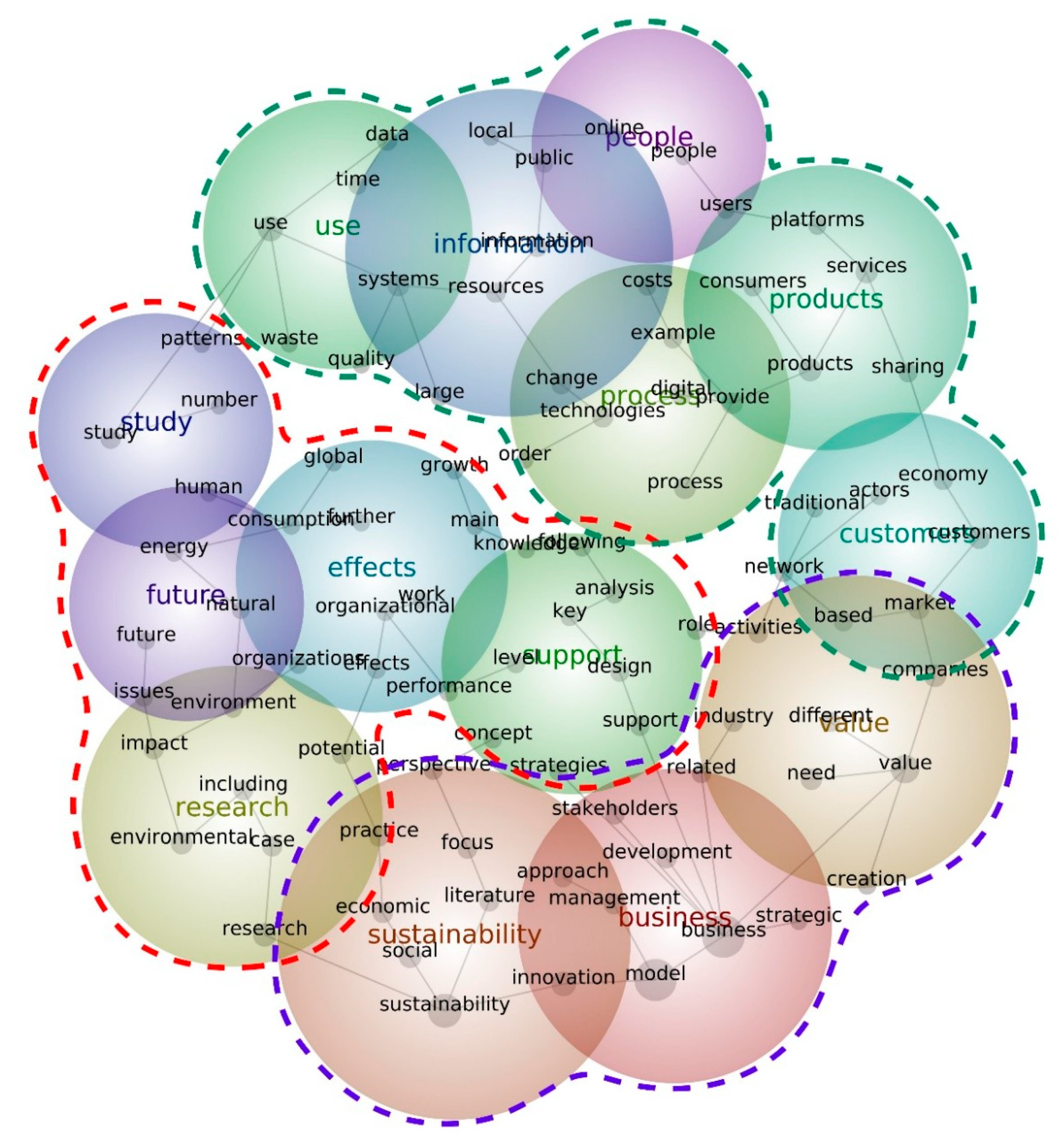
Publisher’s Note: MDPI stays neutral with regard to jurisdictional claims in published maps and institutional affiliations. |
© 2021 by the authors. Licensee MDPI, Basel, Switzerland. This article is an open access article distributed under the terms and conditions of the Creative Commons Attribution (CC BY) license (http://creativecommons.org/licenses/by/4.0/).
Share and Cite
Vidmar, D.; Marolt, M.; Pucihar, A. Information Technology for Business Sustainability: A Literature Review with Automated Content Analysis. Sustainability 2021, 13, 1192. https://doi.org/10.3390/su13031192
Vidmar D, Marolt M, Pucihar A. Information Technology for Business Sustainability: A Literature Review with Automated Content Analysis. Sustainability. 2021; 13(3):1192. https://doi.org/10.3390/su13031192
Chicago/Turabian StyleVidmar, Doroteja, Marjeta Marolt, and Andreja Pucihar. 2021. "Information Technology for Business Sustainability: A Literature Review with Automated Content Analysis" Sustainability 13, no. 3: 1192. https://doi.org/10.3390/su13031192
APA StyleVidmar, D., Marolt, M., & Pucihar, A. (2021). Information Technology for Business Sustainability: A Literature Review with Automated Content Analysis. Sustainability, 13(3), 1192. https://doi.org/10.3390/su13031192








